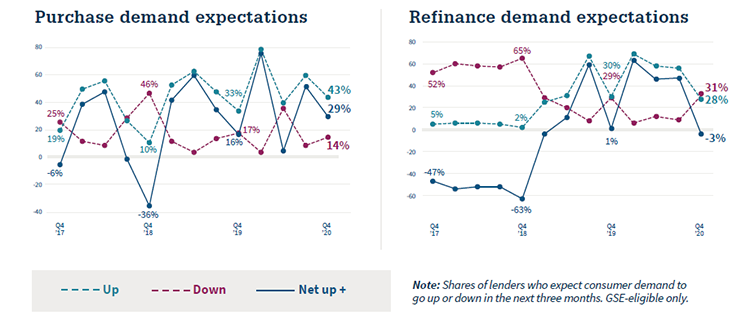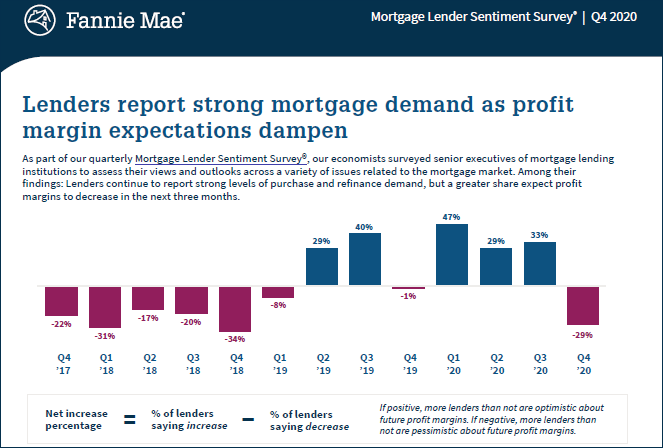Mortgage Lenders Approach 2021 with Cautious Profit Margin Outlook
December 9, 2020
WASHINGTON, DC – Mortgage lenders’ profitability outlook for the next three months declined from last quarter, with a greater share of lenders now expecting profit margins to decrease, according to Fannie Mae’s Q4 2020 Mortgage Lender Sentiment Survey®. According to the fourth quarter survey, only 19% of lenders believe profit margins will increase compared to 48% in the prior quarter, while 33% believe profits will remain the same and 48% believe profits will decrease. These results reflect a dampening of aggregate enthusiasm expressed over the prior six quarters, in which lenders indicated increasingly optimistic profitability expectations.
Reported consumer demand remained strong in the fourth quarter across all loan types, and in many cases remained near or recorded survey highs. Reported purchase mortgage demand over the past three months set a new survey high for GSE-eligible loans and a new fourth-quarter survey high for government loans. Looking ahead, purchase mortgage demand expectations fell compared to the prior quarter but reached new highs for any fourth quarter in the survey's history. For refinances, lenders reported that consumer demand fell on both a looking-back and looking-ahead basis across all loan types but generally remains strong.
"Consistent with key industry indicators, the fourth quarter MLSS results support the strength of the mortgage industry we’ve seen in 2020, despite the pandemic," said Fannie Mae Senior Vice President and Chief Economist Doug Duncan. "The net share of lenders reporting purchase demand growth for the past three months reached a new survey high for GSE-eligible loans. For refinance mortgages, although the net share of lenders reporting demand growth for the prior three months dipped slightly from last quarter’s high across all loan types, it has remained at a historically high level. We currently expect loan origination volume to total $4.1 trillion in 2020, the highest on record since 2003."
"However, moving into 2021, lender sentiment paints a more cautious picture, aligning neatly with our recently reported consumer-side sentiment expectations, which appear to have plateaued, and supporting our forecast for a more modest pace of housing growth," Duncan continued. "Refinance demand growth expectations for the next three months fell significantly from last quarter across all loan types. Additionally, lenders' profitability outlook has weakened. The resurgence of COVID-19 cases and uncertainty around the economic recovery path pose risks to the pace of housing growth. Pending sales and purchase mortgage applications have recently pulled back from highs as pent-up demand from the spring has receded. Tight inventories, along with higher home prices, will likely continue to restrain sales, and the recent compression of the primary/secondary mortgage spread appears to confirm mortgage lenders’ lower profitability expectations."
MORTGAGE LENDER SENTIMENT SURVEY HIGHLIGHTS:
Mortgage spreads compress to pre-pandemic levels but remain above long-term average
After peaking in April, mortgage spreads have narrowed steadily. In November, as the 10-year Treasury increased, the average primary mortgage spread (FRM 30 contract rate versus 10-year Treasury) came in at 190 basis points, returning to pre-pandemic levels. However, mortgage spreads remain above the long-run average of approximately 170 basis points.
Consumer demand remains generally strong for both purchase and refinance mortgages
For purchase mortgages, the net share of lenders reporting demand growth over the past three months rose across GSE-eligible and government loans, reaching a new survey high for GSE-eligible loans and the highest fourth quarter reading for government loans. Looking ahead to the next three months, demand expectations fell from last quarter, but GSE-eligible and government loan expectations reached the highest readings for any fourth quarter in the survey’s history (since 2014).
For refinance mortgages, the net share of lenders reporting refinance demand growth over the prior three months dipped slightly across all loan types from prior quarter. Refinance demand growth expectations, on net, for the next three months fell significantly from last quarter across all loan types but remain similar to the levels seen in the Q4 2019 survey.
Credit standards have tightened but are expected to remain largely unchanged over next three months
Lenders on net continued to report that credit standards tightened for the prior three months, though significantly less so compared to last quarter. Most lenders expect credit standards to stay about the same for the next three months.
Related Links


